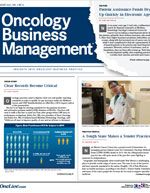Publication
Article
Oncology Business News®
Choosing a Care Model and Making It Work
Author(s):
In June, CMS selected roughly 200 medical oncology practices to participate in the public payer’s own flavor of oncology payment reform: the Oncology Care Model. This program, which launched in July, is designed to lower costs and improve quality of care for treatment episodes that start with a six-month chemotherapy regimen.
Kelly Blair

Kelly Blair
In June, CMS selected roughly 200 medical oncology practices to participate in the public payer’s own flavor of oncology payment reform: the Oncology Care Model (OCM). This program, which launched in July, is designed to lower costs and improve quality of care for treatment episodes that start with a six-month chemotherapy regimen.
Not since the Medicare Modernization Act of 2003, which established buy and bill, has oncology payment reform been as front-and-center. By moving the needle from volume to value, the OCM is an important step, both mechanically and philosophically, to fundamentally change the way oncology services are reimbursed. Is the OCM perfect? No. Does it address the important elements of payment reform? In some ways, yes. Is it a good start? Yes. Perhaps more important than the actual details of the OCM is that we have moved from dialogue and debate to action. Good or bad, we are moving forward.
In the OCM, practices selected are baselined on historical cost, and target episode payments are based on previous performance—so practices are competing against themselves versus a risk-adjusted average. If episode costs come in under the target, the spread between actual and target costs of the episode will define the savings pool. CMS takes 4% off the top, then the practice is eligible to receive 100% of the remaining savings based on eight measures of performance.
Start With Basic Tenets in Developing a Sound Care Model
In addition, practices will receive a monthly case management fee of $160 per patient for the full duration of the six-month episode. In 2018, a two-sided risk model becomes available that qualities as an Advanced Alternative Payment Model under the proposed Medicare Access & CHIP Reauthorization Act rule, which is due for release by November 1.Some have referred to the OCM as a “bundled” payment program. While I don’t necessarily agree, my purpose in this article is not to debate what we call it, but to help providers and other stakeholders prepare for a value- based oncology reimbursement system. Developing a strategy for bundled or episodic payments in oncology can be a daunting task for even the most sophisticated leadership at large health systems. The space is confusing and the stakes are high. Which model do you choose to start with?
Along with sound program mechanics that improve quality and patient outcomes, and simultaneously reduce cost, the following basic tenets should guide any value-based oncology payment model, OCM or otherwise:
- Care should be grounded in evidence-based, standardized protocols, yet allow for a degree of “clinical freedom” to let physicians practice the art of patient care in a way that best meets the needs of individual patients.
- Care should be delivered by coordinated, cross-functional teams that represent the entire continuum of the patient journey. All members of the care team should have access to the patient medical record.
- Patients should have access to a member of the care team 24 hours a day, seven days a week, for questions—whether urgent or not—to assess the situation, provide guidance and support, and direct immediate needs to the appropriate site of service.
- Care delivery should be designed around treating the whole person (clinical, financial, emotional, and spiritual), not just the disease.
- Goals of treatment should be front-and-center and shared decision- making between the care team and the patient should occur throughout the duration of treatment.
- For comfort and quality of life for all patients, palliative care should be an integral part of care, not treated as a stand-alone service for terminal patients.
- Medical oncologists should be compensated based on how well they care for patients versus the drugs they select.
The shape these tenets take in programmatic form can vary, but they will aid the transition toward a system of value-based care that is more affordable and accessible, with uncompromised clinical quality and outcomes. In addition to adherence to these principles, providers should be prepared to demonstrate performance on the basic metrics for any value- based model:
- Compliance with evidence-based guidelines and clinical pathways
- Inpatient admission/readmission rates
- Emergency department admission rates
- End-of-life acuity
- Patient satisfaction
- Total cost of care
Attain System Mastery to Attract Payers
Any provider who can demonstrate mastery over the entire system of care will be an attractive partner to any payer interested in bundles or other value-based models of payment. Don’t get hung up on any one flavor of payment reform. Focus on mastering your system of care and doing it better than anyone else:
- Start where you’re already strong and can show it.
- Pick your care delivery partners before they are chosen for you. Select partners who are both philosophically and financially aligned.
- Know the voice of your customer (the patient). This information should serve as the common ground around which to build consensus with payers and other stakeholder partners.
- Do not assume technology or software is the solution. There are a lot of vendors out there selling value-based solutions. Dashboards, on their own, will not change behavior or deliver better care.
One last important point. Take a lesson learned from the early accountable care organizations: The investment to redesign care delivery is substantial and those willing but not appropriately funded will inevitably fail in the transition. This kind of transformative change does not happen overnight. It requires a comprehensive plan that factors in the economic, operational, and cultural changes required to succeed.
With the abundance of experimentation going on in the oncology payment landscape, one thing is certain: the business and practice of oncology are undergoing deep transformation. Providers that succeed in these value-based models will be those who build effective partnerships across the delivery continuum, commit to capturing the data required for measurement, drive performance on key metrics, and persevere in developing efficient, patient-centered care. Those who demonstrate mastery over their system of care will thrive in a value-based, bundled reimbursement world and be the pioneers who lead the rest of the industry forward.
Kelly Blair is a vice president at Sg2, a company that provides strategic analytics, expertise and consulting for hospitals and health systems.










